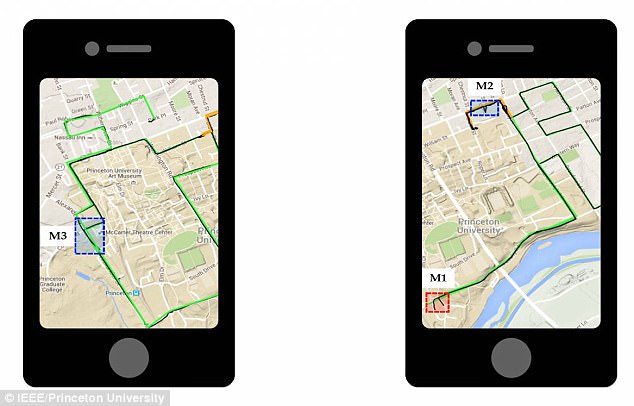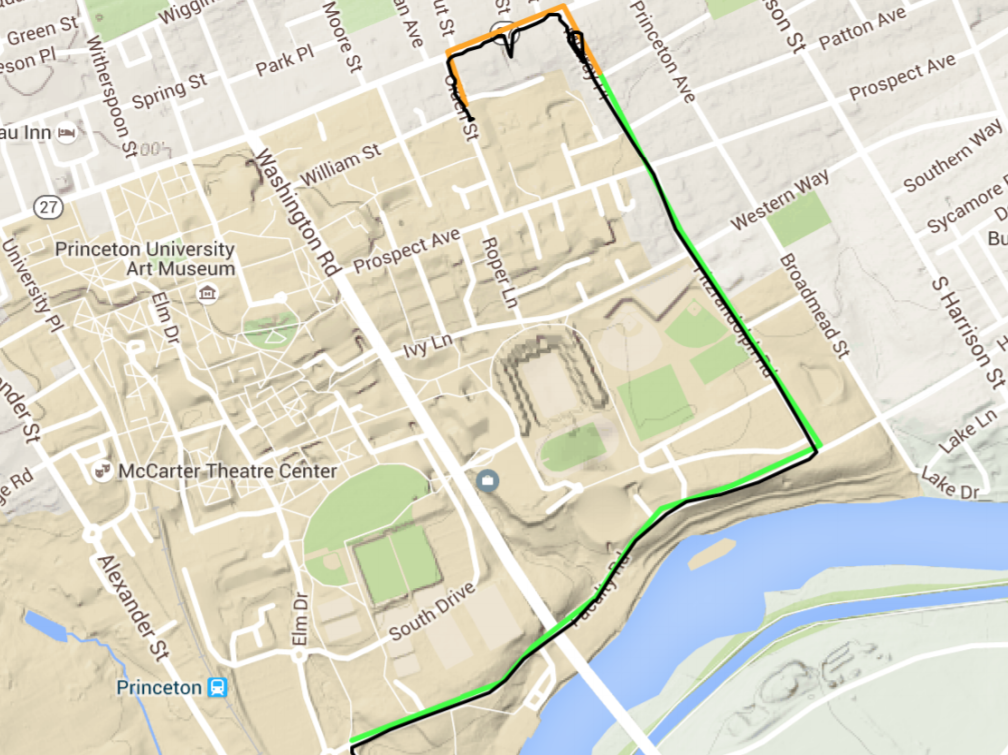Researchers have suggested how to track a smartphone with GPS off
A group of researchers from the Institute of Electrical and Electronics Engineers (IEEE) has developed a PinMe system that allows you to track its location on the basis of open data and information from various sensors of your smartphone with an accuracy comparable to GPS. In this regard, the researchers urge gadget manufacturers to add a software solution that disables the operation of all sensors, and not just GPS.

Scientists have discovered a security gap in smartphones. Comparing the information from the accelerometer and gyroscope with the open data - maps and weather reports, they were able to determine the location of the person, his route and type of transport.
The PinMe application developed by researchers shows how using machine learning methods and information from innocuous sensors, you can get important information about a person’s life, said Associate Professor of Electrical Engineering at Princeton University Pratik Mittal, co-author of the study. Unlike satellite navigation, information from sensors does not require permission to access.
“Hackers can convince a ship or unmanned vehicle that they are in a place that is different from their real location, which can be a problem for US ships navigating international waters, for example, or for the safety of passengers in autonomous cars,” says Nirei Jha , a professor at Princeton University and co-author of the study. According to him, the PinMe team is already communicating with technology companies about licensing the application as a navigation tool.
For the experiment, scientists collected data from the Galaxy S4 i9500, iPhone 6 and iPhone 6S smartphones, which were used by three people during the day after installing PinMe. Experimental walked, traveled by car, train, flew in an airplane around Philadelphia, Dallas, Princeton and other cities.
To begin with, PinMe read the latest IP address of the smartphone and the status of the network to determine the last Wi-Fi connection - this is how the application received the starting point for further work. The application then used an algorithm that was “trained” on it using machine learning to recognize the difference between walking, driving, flying, and other means of movement. For this, data from the sensors were used - the direction and speed of movement, the frequency of stops, as well as the height above sea level.
After determining how to move PinMe included a new algorithm and began to make up the user's route. OpenStreetMaps serviceused to get current navigation data. Google Maps helped determine the location by comparing it with an elevation map. To clarify the route, the application used the Weather Channel weather service : accurate information on temperature and air pressure helps to neutralize the influence of weather conditions on the information collected by the sensors. Route data were compared with the schedule of airlines or railway lines.
When traveling from Philadelphia to Dallas on an airplane, the application first determines the mode of transport based on changes in altitude and acceleration, and then - by time zone, weather, and schedule it finds the place of take-off and landing.
In the illustration below, the route tracked with PinMe — driving and walking by car — is marked in green and yellow; the route is constructed according to GPS data in black.

These researchers were not the first to use accelerometers to track people. In 2010, the Japanese telecommunications corporation KDDI, the mobile operator au, developed an application to track employee movements in the company. The goal of the developers was total control over the employees in order to increase the efficiency of their work. The data from the accelerometer made it possible to determine movement on a flat surface and on a ladder, speed of movement, trips to the toilet. Moreover, a smartphone at the waist of a cleaning lady could tell the difference between mopping, sweeping and shaking out the garbage can.
In 2015, specialists from the Nanjing University in China used data from an accelerometer to monitor the movement of people on the subway: “Subway trains move along rails, so their traffic patterns differ from cars and buses traveling along roads, and since there are no two absolutely identical sections connecting adjacent metro stations, patterns of movement of trains at different time intervals can also be distinguished among themselves. " For work, you need to make a map of the subway, then to determine routes with accuracy from 70% to 92%.
The scientific work was published on February 5, 2018 on the website of the Cornell University Library. DOI: 10.1109 / TMSCS.2017.2751462.

Scientists have discovered a security gap in smartphones. Comparing the information from the accelerometer and gyroscope with the open data - maps and weather reports, they were able to determine the location of the person, his route and type of transport.
The PinMe application developed by researchers shows how using machine learning methods and information from innocuous sensors, you can get important information about a person’s life, said Associate Professor of Electrical Engineering at Princeton University Pratik Mittal, co-author of the study. Unlike satellite navigation, information from sensors does not require permission to access.
“Hackers can convince a ship or unmanned vehicle that they are in a place that is different from their real location, which can be a problem for US ships navigating international waters, for example, or for the safety of passengers in autonomous cars,” says Nirei Jha , a professor at Princeton University and co-author of the study. According to him, the PinMe team is already communicating with technology companies about licensing the application as a navigation tool.
For the experiment, scientists collected data from the Galaxy S4 i9500, iPhone 6 and iPhone 6S smartphones, which were used by three people during the day after installing PinMe. Experimental walked, traveled by car, train, flew in an airplane around Philadelphia, Dallas, Princeton and other cities.
To begin with, PinMe read the latest IP address of the smartphone and the status of the network to determine the last Wi-Fi connection - this is how the application received the starting point for further work. The application then used an algorithm that was “trained” on it using machine learning to recognize the difference between walking, driving, flying, and other means of movement. For this, data from the sensors were used - the direction and speed of movement, the frequency of stops, as well as the height above sea level.
After determining how to move PinMe included a new algorithm and began to make up the user's route. OpenStreetMaps serviceused to get current navigation data. Google Maps helped determine the location by comparing it with an elevation map. To clarify the route, the application used the Weather Channel weather service : accurate information on temperature and air pressure helps to neutralize the influence of weather conditions on the information collected by the sensors. Route data were compared with the schedule of airlines or railway lines.
When traveling from Philadelphia to Dallas on an airplane, the application first determines the mode of transport based on changes in altitude and acceleration, and then - by time zone, weather, and schedule it finds the place of take-off and landing.
In the illustration below, the route tracked with PinMe — driving and walking by car — is marked in green and yellow; the route is constructed according to GPS data in black.

These researchers were not the first to use accelerometers to track people. In 2010, the Japanese telecommunications corporation KDDI, the mobile operator au, developed an application to track employee movements in the company. The goal of the developers was total control over the employees in order to increase the efficiency of their work. The data from the accelerometer made it possible to determine movement on a flat surface and on a ladder, speed of movement, trips to the toilet. Moreover, a smartphone at the waist of a cleaning lady could tell the difference between mopping, sweeping and shaking out the garbage can.
In 2015, specialists from the Nanjing University in China used data from an accelerometer to monitor the movement of people on the subway: “Subway trains move along rails, so their traffic patterns differ from cars and buses traveling along roads, and since there are no two absolutely identical sections connecting adjacent metro stations, patterns of movement of trains at different time intervals can also be distinguished among themselves. " For work, you need to make a map of the subway, then to determine routes with accuracy from 70% to 92%.
The scientific work was published on February 5, 2018 on the website of the Cornell University Library. DOI: 10.1109 / TMSCS.2017.2751462.
